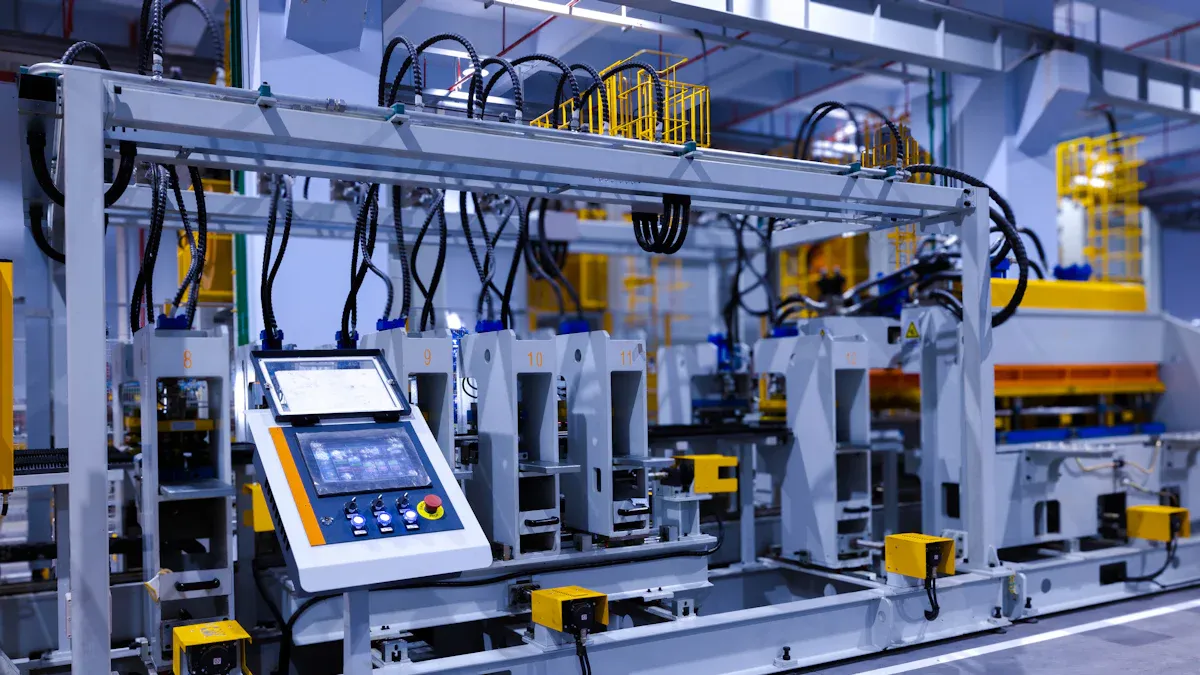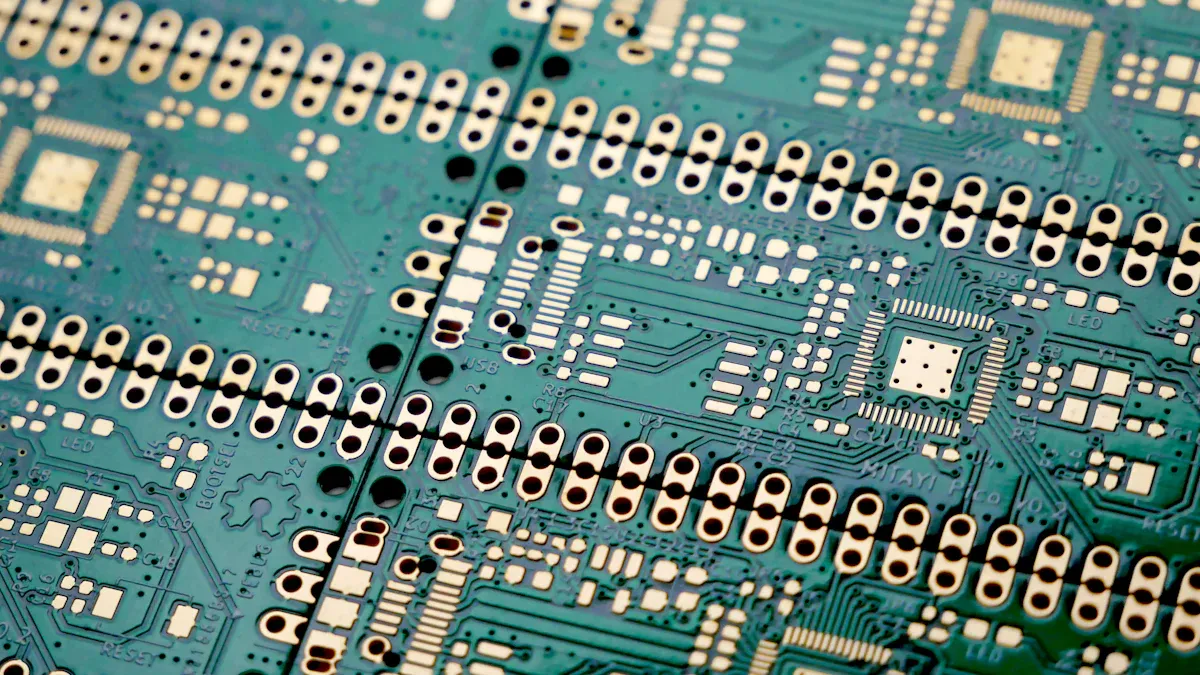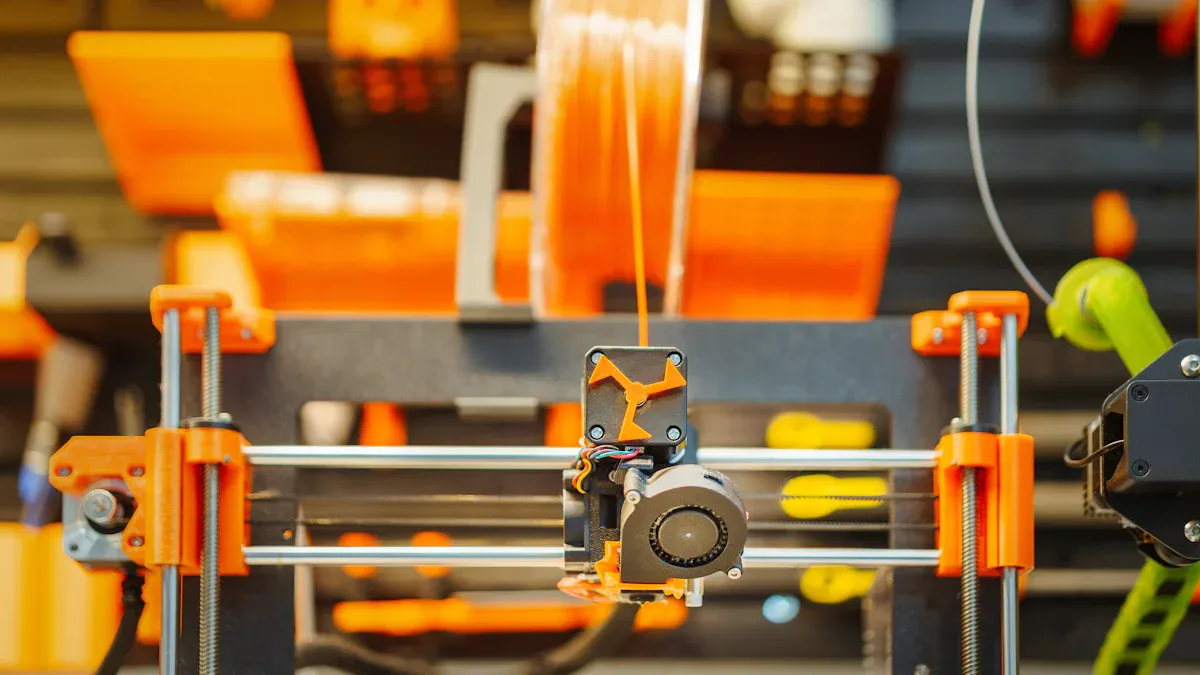
Printed Circuit Board Assembly (PCBA) manufacturing capabilities are essential for producing modern electronics. These capabilities utilize specialized methods to place components onto printed circuit boards (PCBs). By employing tools such as robots and AI, PCBA ensures high-quality products with minimal errors.
The global PCB and PCBA market, valued at $68.4 billion in 2023, is projected to grow to $105.8 billion by 2032. This underscores the significance of PCBA manufacturing capabilities in the production process.
These capabilities not only accelerate production but also enhance quality control. For instance, AI technology now identifies errors and improves the assembly process. As consumers demand smaller and smarter designs, PCBA continues to innovate, supporting industries such as electronics and healthcare.
Key Takeaways
Making PCBA is important for building good electronics. It uses machines and new tech to make things better and fix mistakes.
Quick testing and small productions help companies try ideas fast. This helps them meet needs and sell products sooner.
Certifications like IPC and ISO 9001 keep quality high. They make customers trust the product and follow rules.
A safe supply chain stops fake parts from being used. Trusted suppliers and tracking make products work better.
Testing checks how well PCBA works. Different tests find problems early, making products last longer.
Key PCBA Manufacturing Capabilities

High Precision & Complexity in PCBA
Precision is very important in making circuit boards. As designs get more detailed, modern PCBA can handle advanced features. These include 16-layer boards, tiny parts, and tight spaces. This helps create small, efficient designs that still work well. For example, special vias connect layers in multi-layer boards. This saves space and makes the boards work better.
New technology has made precision even better. Machines now place parts automatically, reducing mistakes. Better soldering methods make sure connections are strong and consistent. These improvements make electronics more reliable, even in complex designs. Using these tools, industries like healthcare and telecom can meet their high standards for accuracy.
Certain measurements show how well PCBA processes work. Things like First Pass Yield (FPY) and defect rates show quality. Cycle time and throughput measure how fast production is. Waste and rework rates show where to improve. Watching these numbers helps keep manufacturing precise and efficient.
Rapid New Product Introduction (NPI) in Electronics Manufacturing
Bringing new products to market quickly is crucial today. PCBA helps by allowing fast prototyping and small-batch production. This lets you test and improve designs before making many units. Quick switches between product lines also help meet market needs faster.
Small-batch production is great for startups and inventors. It’s a cheaper way to test ideas and get feedback. Flexible production lines can make different products at the same time. This speeds up production and gives you an edge in the market.
Following rules and getting certifications also help the NPI process. Standards like IPC and ISO 9001 ensure prototypes meet industry rules. Environmental laws like RoHS and REACH make products safer and greener. These steps improve quality and build trust with customers.
Automation & Intelligence in PCBA Manufacturing
Automation has changed how PCBA is done, making it faster and better. Machines like SMT place parts on boards automatically. Tools like SPI and AOI check quality during each step. X-ray machines find hidden problems in solder joints.
AI makes automation even smarter. Companies like Bosch use AI to check solder points with great accuracy. AI also studies data to find problems quickly. This keeps quality high and reduces the need for extra testing.
Automation also saves energy. AI systems can cut electricity use and lower CO₂ emissions. For example, Bosch reduced energy use by 18% and emissions by 14%. This saves money and helps the environment. By using automation and AI, you can make better products, avoid mistakes, and support a greener planet.
Certifications & Compliance in PCBA Processes
Certifications and rules are very important for making good PCBA. Following these rules helps meet customer needs and keeps quality steady. They also make products safer and better for the environment.
One well-known set of rules is the IPC standards. These rules cover many parts of PCBA, like soldering and testing. For example, IPC-A-610 checks if soldering and cleaning are done well. IPC-J-STD-001 focuses on soldering to avoid mistakes and make strong connections. Below is a table showing key IPC rules and their benefits:
IPC Standard | Description | How It Helps |
|---|---|---|
IPC-A-610 | Acceptability of Electronic Assemblies | Makes sure soldering and cleaning are high quality. |
IPC-J-STD-001 | Requirements for Soldered Assemblies | Reduces mistakes and ensures strong solder joints. |
IPC-6012 | Qualification for Rigid Printed Boards | Checks PCB performance and reliability. |
IPC-7711/7721 | Rework and Repair Guidelines | Keeps products reliable during fixes. |
IPC-A-620 | Cable and Wire Harness Assemblies | Ensures safe and good cable assemblies. |
IPC-TM-650 | Test Methods Manual | Confirms products meet performance rules. |
IPC-7351 | Surface Mount Design Guidelines | Improves PCB layout and lowers soldering mistakes. |
Using these rules makes PCBA better and builds customer trust. Certifications like ISO 9001 and AS9100 show you care about quality. Following environmental rules like RoHS and REACH keeps products safe and eco-friendly.
Focusing on certifications and rules makes PCBA more reliable. It lowers mistakes, improves product quality, and keeps customers happy.
Supply Chain Security in Electronics Manufacturing
A strong supply chain is key for good PCBA. A secure supply chain stops fake parts and keeps materials high quality. This is very important for industries like healthcare and aerospace.
To keep your supply chain safe, use tools like material checks and tracking. These tools confirm parts are real and not fake. For example, following JSOX and DFARS rules ensures your supply chain is secure.
Tracking is also very important. Advanced systems let you follow every step, from materials to final products. This helps find and fix problems fast and builds trust in your products.
Working with trusted suppliers is also smart. Certified vendors lower risks and provide good materials. This keeps PCBA production smooth and reliable.
By focusing on supply chain safety, you avoid risks and make better products. This helps you meet high standards and stay ahead in the market.
Impact of PCBA Manufacturing Capabilities on Electronics Design
Improving Efficiency and Flexibility in Design
PCBA manufacturing helps make electronics design faster and more flexible. Tools like automated machines and smart inspection systems speed up production. These tools also reduce mistakes, helping you meet deadlines with good quality.
For example, machines place parts quickly and accurately. Smart inspection tools find errors early, lowering rework needs. Well-planned production lines keep work flowing smoothly. Using these methods reduces waste and uses resources wisely.
Advanced Method | How It Improves Efficiency |
|---|---|
Speeds up production and places parts accurately | |
Smart Inspection Tools | Lowers rework and boosts efficiency |
Good Production Line Setup | Keeps production smooth and efficient |
Precision Tools | Makes products accurate and reduces mistakes |
Smart Production Control | Saves money and improves processes |
Eco-Friendly Technology | Cuts costs and helps the environment |
Flexibility is also key in design. Small-batch production and quick prototyping let you test ideas. This helps startups and inventors adjust to market needs fast. With PCBA tools, you can make devices that fit different customer needs.
Making Products Reliable and Long-Lasting
Reliability is very important in electronics. PCBA processes focus on making products work well for a long time. Trusted suppliers provide good parts, which are tested carefully. Automated assembly places parts correctly, and inspections like AOI and X-ray find problems.
These steps make products last longer. For example, picking good parts and assembling them well lowers failure risks. Tests like stress screening and heat tests ensure durability. Reliable products build customer trust and a good reputation.
Leading Innovation in Electronics Manufacturing
PCBA drives new ideas in electronics. People want smaller, better devices, so miniaturization is improving. HDI and flexible PCBs help make tiny designs that still work great. These advances let you create modern products people want.
The car industry shows this change. Electric vehicles (EVs) need advanced PCBs to work. EV sales grew from 206,000 in 2013 to over 10.5 million in 2022. This shows how important PCBA is for making better cars.
Smaller devices need advanced miniaturization techniques.
HDI and flexible PCBs help create compact, efficient designs.
EVs push PCB technology forward with complex needs.
By using these innovations, you can stay ahead in electronics. PCBA not only helps create new ideas but also gets products to market faster. This gives you an advantage in the industry.
Speeding Up Product Launches
Getting products to market fast is very important today. PCBA helps speed up this process. It uses smart tools to make production quicker and better. This reduces delays and keeps quality high.
Modern PCBA uses robots and AI to lower mistakes. These tools make production faster and more accurate. Data systems also help improve workflows. They manage resources well and keep production steady. For example:
Data tools help manage resources and save time.
Quality control systems keep production smooth and reliable.
PCBA also helps with scaling production. Companies like MacroFab use many factories to meet demand. Real-time data helps engineers make quick decisions. Supply chain teams solve problems to avoid delays. These steps help products reach the market faster.
Prototyping is another way PCBA helps. Quick prototypes let you test ideas fast. Small batches allow feedback and fixes before big production starts. This makes sure products meet customer needs on time.
Using PCBA tools saves time and improves product quality. Faster launches give you an edge and keep customers happy in a fast-changing industry.
Overcoming Challenges in PCBA Manufacturing
Handling Complex Designs and Smaller Components
Electronics are getting smaller and more advanced. This makes PCBA harder because tiny parts need exact placement. Special machines and skilled workers are needed for this. For example, dense designs can cause problems like signal issues or overheating. Less space for cooling makes heat control very important.
To solve these problems, use special methods like micro vias. These save space but still work well. Tools like AOI and X-ray checks help find mistakes and place parts correctly. Using these tools ensures your PCBA is precise and reliable, even for tricky designs.
Dealing with Supply Chain Problems
Supply chain issues are a big challenge in electronics. Things like natural disasters or factory closures can slow production and raise costs. These problems often cause shortages of parts, making it hard to meet deadlines.
To avoid these issues, use strong supply chain plans. Tools like tracking systems check if parts are real and good quality. Working with trusted suppliers who follow rules like JSOX helps keep your supply chain safe. These steps reduce delays and keep materials flowing for your PCBA work.
Keeping Quality in Large-Scale Production
Making many PCBA units needs strict quality checks. Without them, mistakes can grow, costing more money and upsetting customers. Tools like SPI check soldering, and ICT tests if parts work properly.
Automated tools like AOI and FCT catch problems early. This improves product quality and reduces waste. Good quality control builds customer trust and makes your company look good in the electronics world.
Adapting to Technological Advancements in Electronics Manufacturing
New technologies are changing how PCBA manufacturing is done. Keeping up with these changes helps your processes stay fast, affordable, and competitive in today’s electronics world.
Modern tools now make small production runs possible. Before, these were too expensive and slow to be practical. With advanced systems, you can create prototypes or small batches without losing quality or time. This is very helpful for startups and companies testing new ideas.
Tip: Small-batch production lets you try ideas quickly and adjust to market needs.
Smart platforms have made sourcing and assembly easier. These systems combine tasks, so you don’t need many vendors. This makes your supply chain simpler and faster. Products that used to take weeks can now be ready in days. This speed helps you launch products faster and stay ahead.
Here are some benefits of using advanced PCBA tools:
Faster Turnaround: Products are made quicker and reach the market faster.
Cost Efficiency: Small batches save money and resources.
Simplified Processes: Fewer vendors mean less work and fewer delays.
Improved Quality: Better tools make products more reliable.
Automation and AI make these tools even better. Machines with AI find mistakes right away, keeping quality high. Automated systems also save energy and reduce waste. For example, AI tools use less electricity and help meet environmental goals.
By using these new technologies, you can improve your PCBA processes. This makes your work faster, better, and ready for the changing electronics industry.
The Role of Testing in PCBA Manufacturing

Why Testing is Important for Reliable PCBA
Testing is key to making sure PCBA works well. It finds problems early, stopping costly mistakes later. Careful testing ensures electronics meet quality standards and work in different conditions.
Tests like HALT and HASS check how strong PCBA is. HALT uses heat and vibration to test parts. HASS finds weak spots in the assembly process. Electrical tests, like checking connections, make sure the PCBA works properly.
Using these tests improves product quality and lifespan. This builds customer trust and helps you stay ahead in the electronics market.
Types of PCBA Testing: ICT, FCT, and Stress Tests
Different tests check different parts of PCBA performance. ICT finds electrical problems like broken connections. FCT tests how the whole PCBA works in real-life situations. Stress tests check if PCBA can handle tough conditions like heat or shaking.
Testing Type | What It Does |
|---|---|
Finds electrical issues and checks if parts work. | |
FCT Test | Tests how the PCBA works in real-world conditions. |
Stress Test | Checks if PCBA can handle heat, vibration, and other tough conditions. |
These tests make sure PCBA works well and meets all requirements.
Keeping Electronics Stable and Working Long-Term
Electronics need to last a long time, especially in healthcare or aerospace. Aging tests check how PCBA performs over time. These tests run for days to find problems and improve production.
During aging tests, engineers watch things like voltage and temperature. This helps predict how long the PCBA will last. Stress tests, like heat and vibration checks, make sure the PCBA is strong.
By using these tests, you can make reliable products that work well for years. This keeps customers happy and shows your company makes high-quality electronics.
PCBA manufacturing is crucial for making high-quality and reliable electronics. It helps speed up production, cut costs, and create new designs. Here are some examples:
Improvement | How It Helps Electronics Production |
|---|---|
Speeds up work, lowers labor costs, and boosts output. | |
Greater Precision | Makes products more accurate, reduces mistakes and fixes. |
Smaller Designs | Allows tiny PCBAs for compact and modern devices. |
Lower Costs | Cuts expenses, making advanced gadgets cheaper to produce. |
New Innovations | Helps create better products with improved features. |
“As technology grows, more complex circuit boards will be needed. What is advanced today will soon become normal tomorrow.”
To keep up with modern electronics, advanced PCBA tools are essential. These include automation, AI for quality checks, and HDIs. Using these tools helps solve problems, spark new ideas, and stay ahead in the fast-changing tech world.
FAQ
What is PCBA, and why does it matter in electronics?
PCBA means Printed Circuit Board Assembly. It adds parts to a PCB to make devices work. This process makes sure electronics are reliable and meet quality rules. It also helps create small gadgets and powerful systems.
How does automation help in PCBA manufacturing?
Automation makes production faster and lowers mistakes. Machines like SMT tools place parts accurately. AOI systems find problems early. These tools make electronics better and save time.
What certifications are important for PCBA processes?
Certifications like IPC-A-610 and ISO 9001 check quality. IPC rules focus on soldering and testing. ISO shows you care about steady quality. Following these builds trust and meets industry rules.
How does testing make PCBA products reliable?
Testing finds problems before products are sold. ICT checks connections, and stress tests see if products handle tough conditions. These tests make sure electronics last and work well.
Why is supply chain safety important in PCBA?
A safe supply chain stops fake parts and keeps materials good. Tracking tools check if parts are real. Trusted suppliers lower risks and keep production smooth.
See Also
Understanding PCBA Services and Their Importance in Electronics
The Significance of PCBA Prototyping for Electronic Advancements
Exploring PCBA Manufacturing and Its Importance in Industry